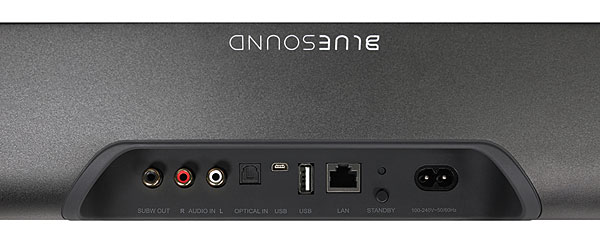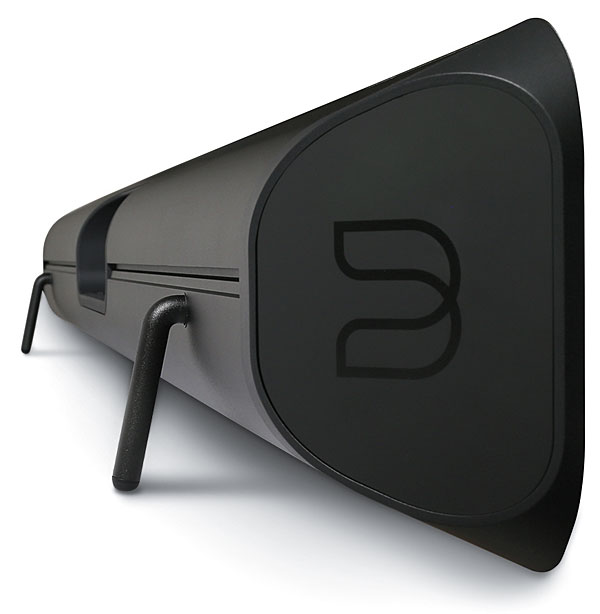Bluesound Pulse Soundbar and Pulse Sub Review

AT A GLANCE
Plus
Excellent musical sound quality
Notable bass extension, with or without sub
Many streaming capabilities, including hi-res audio
Multiroom system
architecture
Visually outstanding
Minus
Some level and dynamics limitations
Occasional cumbersome or inconsistent operation
THE VERDICT
Accurate, dynamic musical sound, lifelike stereo imaging, and remarkable bass extension and control—plus extensive multiroom streaming abilities—easily counterbalance the few ergonomic quirks of a lovely, ultra-compact design.
Don’t look now, but the soundbars are gaining on us. Hardcore home theater heads like you and me can scoff all we want, but consumer electronics’ all-inone answer to audio for video is getting better, smarter, bassier, and popular-er, by leaps and bounds. High-end-ier, too.
For Exhibit A, take the Pulse Soundbar, the latest addition to Bluesound’s wireless-audio ecosystem. Bluesound, the Canadian brand making a serious run at Sonos, lives under the Lenbrook corporate tent, which means it has access to the considerable engineering and design talents of the NAD and PSB families. Which in turn means my expectations were high.
As with the rest of the Bluesound lineup of wholehouse wireless/wired speakers and streamer/amplifiers, the Pulse Soundbar runs a proprietary (duh!) tech called BluOS. This travels the Wi-Fi pathways laid by your home’s network and supports all the usual audio file formats (MP3, AAC, WAV, etc.). It also supports highresolution audio up to 192/24 (including lossless FLAC and ALAC but not DSD) and even MQA, the relatively new compression scheme that allows streaming of hi-res files from encoded services. BluOS can stream files from network “shares” of Windows XP-and-up or Mac OS X up to 10-point-whatever, or directly from plugged-in USB media. It also incorporates internet streaming services, from free radio (TuneIn) to a host of subscription outlets, including Slacker, Napster, Spotify (Connect), and Tidal (which now serves up some content with MQA). No internet connection is required for local file-streaming off your network, however.

The Pulse Soundbar itself is one slim stick, less than 3 inches deep by about 42 x 5 inches. It’s one of the svelter higher-performance soundbars available, and it’s very elegantly finished in black, matte-anodized aluminum, rubberized plastic, and a perforated metal grille; I adored its serious, high-end, Euro-tech look and feel. On board are two three-way sets of soft-dome tweeter, cone midrange, and cone woofer, as well as dual passive radiators, and there’s tri-amplification totaling “120 watts of DirectDigital” power. (While the Pulse bar is strictly a two-channel, non-surround solution, Bluesound is said to be working toward multichannel wireless architecture that would allow grouping multiple standalone speakers.) The soundbar’s response is spec’d down to 55 hertz (–3 decibels), which is damned impressive for something shaped more like a guitar neck than a loudspeaker. Nonetheless, Bluesound has simultaneously bowed the Pulse Sub, a compact wireless subwoofer said to extend a 2.1 Pulse system right down to 26 Hz. We sampled both, of course, and I’ll report on performance both ways.
Setup
The Pulse Soundbar is a surprisingly heavy cylindrical section, and it looks terrific from any angle, but there’s no way it’s going to sit up on its own. A slide-on wall-mount bracket is supplied right in the box. But, for the earthbound like me, Bluesound includes two L-shaped kickstands that slip into back-panel openings, where they snick into place magnetically—sweet!—to provide a stable, slightly back-tilted stance. These props are positioned far apart, though, so a stand or tabletop much less than 30 inches wide won’t cut it. My usual centerspeaker stand wasn’t nearly wide enough, so I placed a couple of masonry blocks to bring the bar just below the bottom edge of my 55-inch TV. Not terribly elegant, but solid.
Setting up the Pulse Soundbar is different from how you handle more conventional bars because of its wireless multiroom audio capabilities. The BluOS controller software—available for iOS, Android, and Mac/Windows PC (all free downloads)—is required for both setup and everyday ops, but once you have one or more on your devices or desktop, the process is fairly straightforward and self-prompting. Bluesound and BluOS have been amply covered in these pages before, so I’ll mostly touch on newer features and operation of the Pulse Soundbar only.

Of course, beyond streaming music from the BluesOS app via its wireless or Ethernet connection, the Pulse provides two hardware inputs to get sound from your TV: one stereo analog on RCA jacks, one optical digital via a Toslink port. There’s no HDMI—the soundbar is strictly audio—so the Audio Return Channel feature of most current TVs is moot. I connected the analog and Toslink outputs of my Vizio M series TV to the bar’s corresponding inputs. My TV’s analog output is volume-controlled by its Vizio remote, but the optical out is fixed-level.
Fortunately, the Bluesound bar, like many others, has a remote-mapping routine that learns commands from most any infrared remote. Finding information about this was arduous, however. There’s no mention of it in the Quick Setup Guide, nor in the online manual (more like an info sheet). Searching for “infrared” on Bluesound’s Support webpage returned a short procedure and directions to the learning page, which nests several levels deep in the BluOS app’s Settings menu.
Once there, the procedure was painless—in about 3 minutes, I had my TV remote’s volume and mute keys commanding the soundbar, and an unused TV-remote key programmed to select the bar’s optical input, for TV watching. A better alternative, as I learned late in my evaluation (and only with Bluesound’s advice, having not noticed it on my own and lacking any mention of it in the documentation), is to train the bar’s optical input to respond to the TV remote’s Power On IR command. In practice, this functionality worked just fine and guaranteed sound from the TV the moment I turned it on, without having to manually select the correct input. With this setup, if you return to music listening after watching TV, the selection of network-sourced (or Bluetooth) music in the app automatically reverts the bar back to its wireless input. Of course, if you left the TV on through the music session to monitor the game, attempting to return to TV sound (the optical input) by hitting the TV-remote Power button will select the right audio input on the bar—but will switch the screen off. In such a case, you would have to navigate back to the bar’s input screen a couple of swipes away to select the optical input manually. For most everyday use, though, this won’t be a problem.
Unfortunately, once I did finally have my TV remote programmed to operate the soundbar, I found that the volume up/down commands don’t map in a linear fashion: Pressing either for more than a second caused large volume jumps, requiring quick momentary jabs to fine-tune levels.
Bar Bands
I began my listening with the Pulse Soundbar reproducing in full range, without the Pulse Sub, and my first reaction was, whoa—bass! The svelte black bar really did produce musical bass plenty low enough for satisfying oomph on most material—pop, jazz, and rock—and it did so with enough authority to elicit a respectful “wow” from experienced listeners. A typical pop production like the Eagles’ “Hotel California” showed solid bottom with a very respectable dose of impact, even up to slightly louder than comfortable-conversation levels. Bass and kick-drum were very slightly on the warm, bloomy side, but it was nothing—nothing—like the faux bass I hear from typical cheap (and not-so-cheap) soundbars and Bluetooth speakers. Midrange definition was outstanding and treble balance just about right, so that the timeless guitar solos by Don Felder and Joe Walsh, and the subsequent harmonized parts, had all their familiar bite and crunch.
Vocal honesty was very fine as well, and not just “for a soundbar.” A range of familiar male-vocal test subjects—such as James Taylor, Donald Fagen, and Lyle Lovett—all displayed their characteristic timbral flags: gooey, nasal, and reedy, respectively. I found Mark Knopfler’s “Sailing to Philadelphia” in hi-res on Tidal Masters/MQA, and I was impressed by the warmth and definition of Knopfler’s and guest Taylor’s voices on this duet (improbably about Dixon and Mason, the British surveyors of the eponymous Line), as well as by convincing treble air and ambience.
The Pulse Soundbar clearly showed its best on natural-acoustic music, and particularly on chamber music—not too surprising, considering that its design was balanced by PSB’s Paul Barton, himself a classical violinist who took a wrong turn and somehow ended up in speaker design. Also found on Tidal, a performance of Bartók’s String Quartet No. 5 produced arresting string tone, bright and bitey but still woody and rich, along with a distinct element of depth and quite impressive detail. Left-to-right imaging was rock-steady and nicely delineated, with the aforementioned depth contributing a valuable illusion of widening to what is necessarily a fairly tight soundstage.
The soundbar’s overall balance is distinctly on the warm side. Under direct comparison, typically neutral conventional speakers sound obviously brighter, with airier treble and more sharply etched transients like hi-hat rides and brass attacks. But close listening told me that the Pulse preserves these elements so that they’re eminently present and eminently natural, as well as in proportion—just pulled back a fair degree. This is possibly a conscious design choice to emphasize how the sound is in contrast to typically tinny, buzzy in-TV reproduction. In any case, from a designer like Barton, it’s very unlikely to be unintentional.
In my 22 x 16-foot studio, the soundbar could play plenty loud enough to deliver real-life chamber-music levels with glowing fidelity, but it ran somewhat short of a full orchestra’s in-hall equivalent on material like Stravinsky’s Firebird suite. Here, I preferred its presentation a click or two short of its pegged volume; otherwise, dense midrange like the last page or two of Firebird could sound slightly congested. And of course, rocking out was similarly limited. A hires file like the Rolling Stones’ “2120 South Michigan Avenue” sounded great at what I call “over-40 party” settings, but the soundbar’s limit was well short of club levels. At the uppermost volume reaches, the Pulse did well with dynamic chamber music or jazz, but both a bit brighter/harsher and a bit bass-boomier on strong rock. There likely is a good deal of “smart limiting” going on in the bar’s internal DSP, and this generally worked very well indeed.
It can only do so much, though, and the Pulse—in common with every similarly compact soundbar I’ve encountered, and many larger ones—can’t equal a carefully chosen combo of full-range stereo speakers and receiver/amplifier of comparable total cost for ultimate level and dynamic impact.
























































